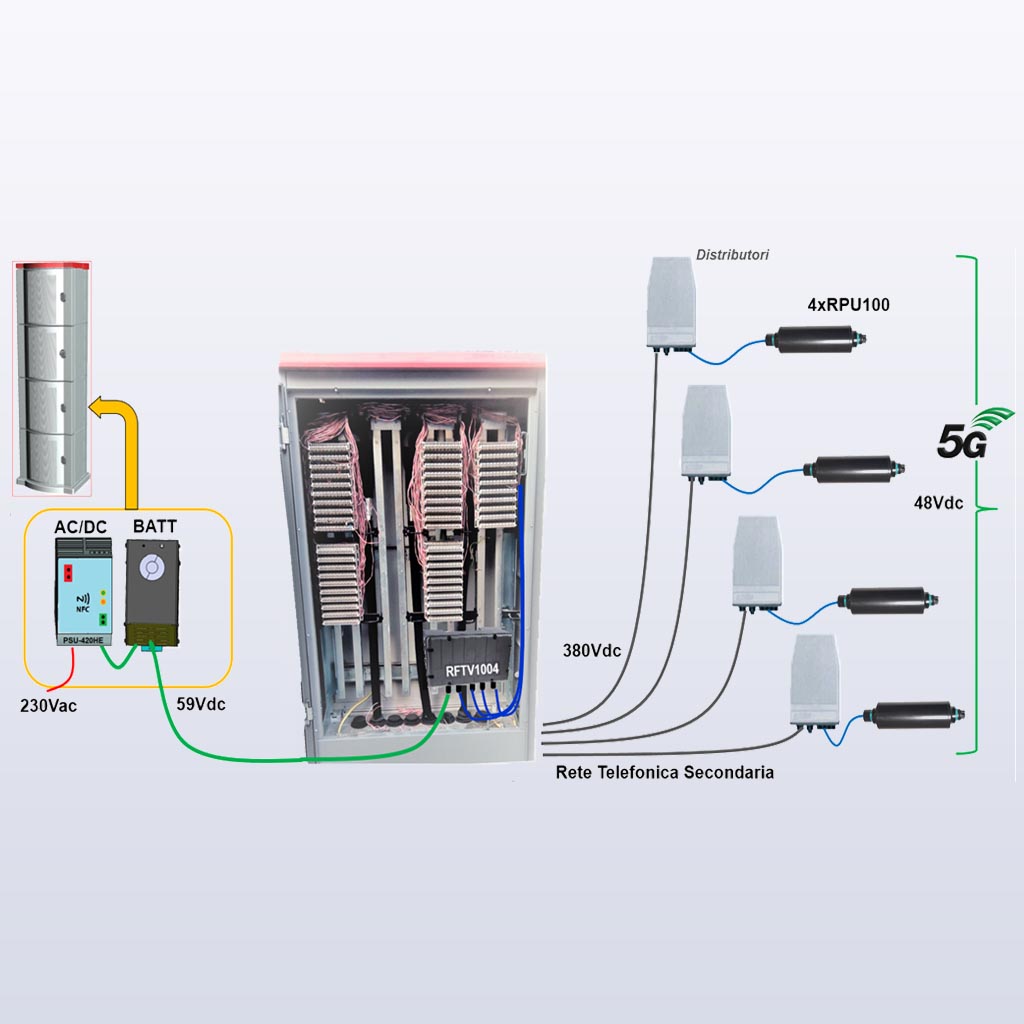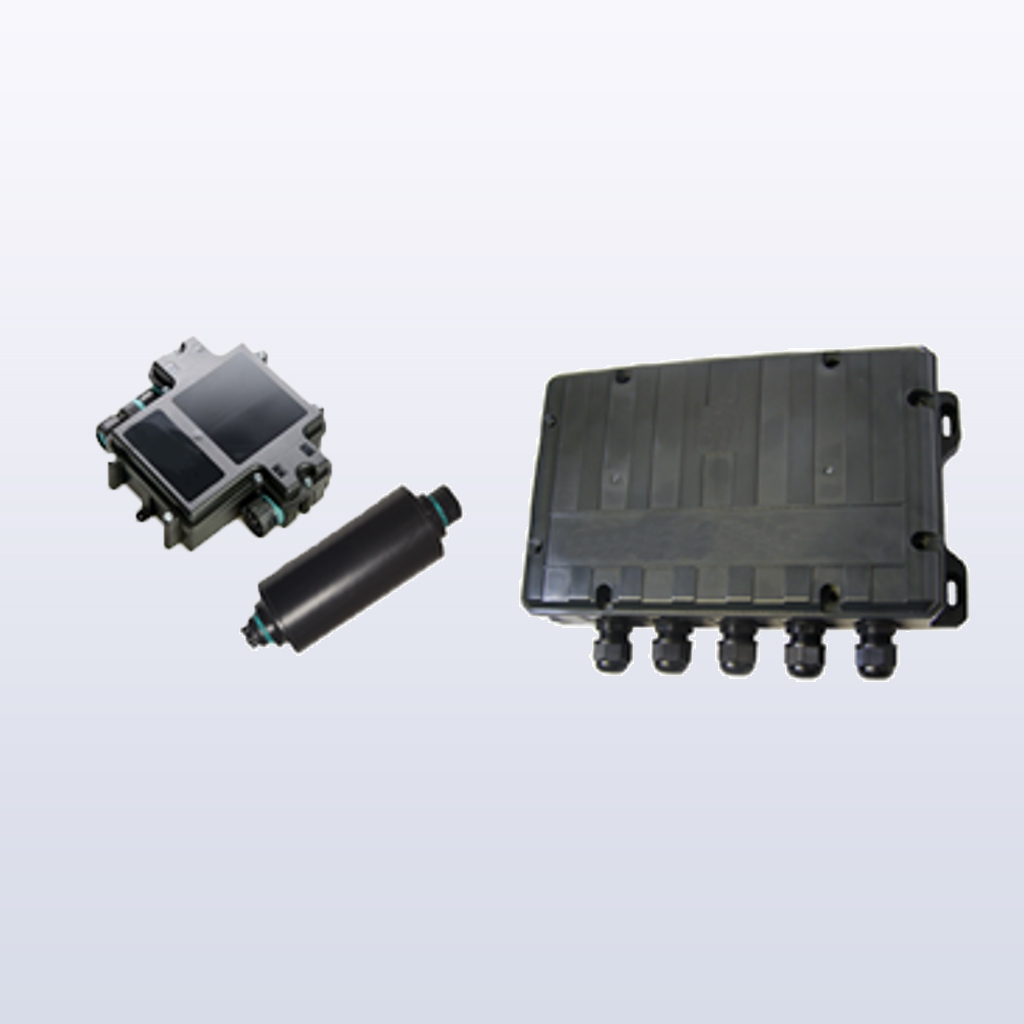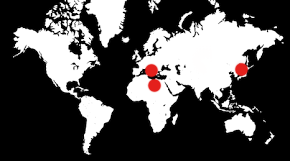RFTV1000
Remote feeding telecommunications system


The needs
The continuous growth of 4G and 5G network connected devices requires more capillarity and coverage density, in order to offer reliable data connectivity services with high performances in terms of speed and latency. In urban areas with a high population density, in order to overcome the risk of mobile network nodes (macro cells) saturation, telco operators can use smaller access devices (small cells) with lower energy consumption, capable of cover smaller area and installed in those area which require more concurrent data services availability.
The use of small cells allows network operators to deploy, in a flexible and modular way, a greater number of network resources in order to offer the required data connectivity quality.
The use of small cells shows the need of an equally capillary presence of electrical power suitable to their feeding.
Mobile network operators can use various methodologies to bring electricity to small cells, including the use of RFT-V (Remote Feeding Telecommunication - Voltage limited) technology which allows the reuse of the old copper phone lines as power transmission lines, from the point where the main power supply is present (e.g. telco street cabinet) to the remote points where the small cells to be powered are installed.
An RFT-V system consists of an up-converter to distribute an LVDC power supply (+/-190Vdc) in a safe and balanced way on one or more copper phone lines, and a remote down-converter (far even over 1km away) which provides the local 48Vdc power supply for the small cells from the copper pairs connected to the LVDC system.
These needs, aimed at a simpler and cheaper deployment of small cells for 4G and 5G network access, led SEMAR group to define a remote power feeding system in RFT-V technology expressly designed for this type of application.
The challenges
- LVDC distribution system with power up to 100W
- Maximum distance from remote unit of at least 1000m
- Compliance with RFT-V systems as per IEC 60950-21 and EN 302 099
- Electrical measurements and checks on copper cable pairs before and during the LVDC distribution
- 48-60Vdc main power supply
- Support for the use of multiple cable pairs to increase distance, power or redundancy
- Possibility of integration with local telco cabinet control systems (RS485 modbusRTU, BLE)
- Possibility of remote management and monitoring (via cellular network) and dedicated WEB application
- Compact dimensions and IP degree suitable for outdoor use
- Wide range of operating temperatures (street side cabinets exposed to the sun and bad weather)
- Resistance to mechanical stress (vibrations on street installations)
The realization
The RFTV1000 system designed by iSEMAR is an RFT-V system capable of remotely power feeding, through a single twisted pair of copper, various telecommunications equipment (4G/5G small cells, FWA transmission systems, xDSL/G.Fast DPU…) installed up to 1km away from the LVDC distribution point.
The system, composed by a distribution unit (single port RFTV1001 or four ports RFTV1004) and a remote unit RPU100, is powered with the 48-60Vdc power supply already present in the telco street cabinets.
The RFTV1001 and RFTV1004 distribution units generate a balanced voltage of +/- 190Vdc on each copper pair, and are able to inject a power of up to 100W per pair, in compliance with IEC 60950-21 standard for RFT-V circuits.
The RPU100 remote unit converts the 380Vdc on the input pair to a 53Vdc 1.8A supply in order to power feed 5G cells or FWA systems.
The RFTV1001 and RFTV1004 distribution units are made of plastic with IP68 protection degree and are suitable for installations inside street side cabinets, while the RPU100, with the same IP68 degree of protection, thanks to its cylindrical shape can be easily installed on supporting poles or cables nearby the remote device to be power fed.
Distribution unit features are compliant with the EN 302 099 V2.1.1 standard for RFT-V power distribution.
Before generating the LVDC supply (+/-190Vdc) on the single line, the distribution units perform tests (MELT) to check the connected copper pairs and to ensure the correct system configuration (e.g. presence of the RPU100 remote device) and safety conditions. Then the system continuously performs measurements and checks even when remote unit is fed, in order to immediately detect possible alterations in the LVDC electrical circuit (e.g. line unbalance to ground) and thus ensure system and operator safety.
Both RFTV1001/1004 distribution units can manage the aggregation of up to four pairs in a single ‘power-path’. This configuration allows both to increase the maximum distributed power (up to 400W) and the extension of the maximum line length between the distribution point and the remote unit.The use of multiple pairs for the single ‘power-path’ can also be used as redundancy/backup in order to maximize the reliability of the remote fed system.
Lines aggregation can be configured both on the four lines of the RFTV1004 unit, and by interfacing in secure wireless mode up to four different RFTV1001 single port unit.
Both RFTV1001/1004 distribution units have multiple local and geographic communications interfaces (RS485 Modbus, AP/STA WiFi, Bluetooth/BLE, NB-IoT, GPRS) that allow the management and monitoring of the entire system using the iTHINGS WEB application dedicated to RFTV1000 system or integrating it into the telco management system.
CONTACTS
Via Sardegna 5, 60022
Castelfidardo (AN)
Italy
T +39 071782481
F +39 0717824824
info@isemar.biz


